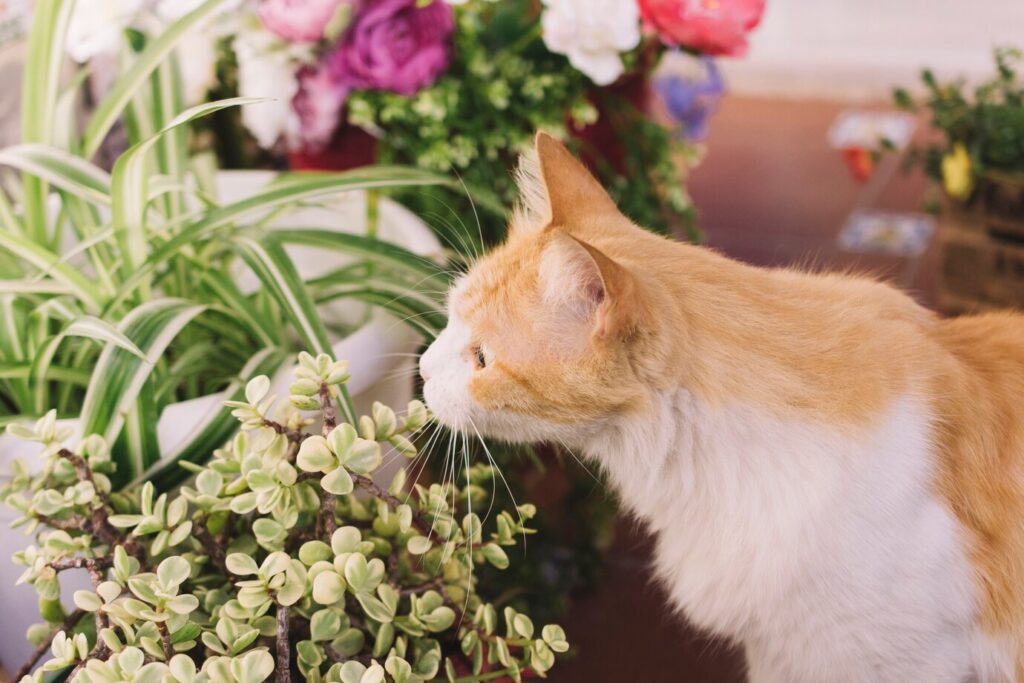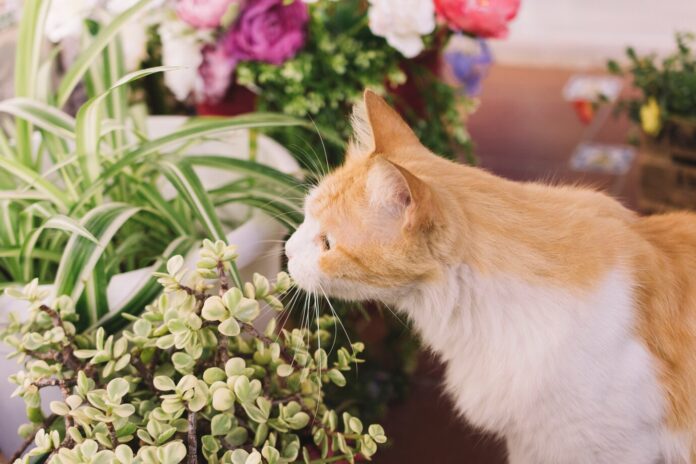Cats are beloved pets for many people around the world, but their natural instincts can sometimes lead to problems in gardens and yards. One common issue that cat owners face is their feline friends damaging flowers. It can be frustrating to spend time and effort cultivating a beautiful garden, only to have it destroyed by curious cats. In this article, we will explore the reasons why cats are attracted to flowers, the potential dangers of them consuming certain types of flowers, and various strategies for keeping cats away from your precious blooms.

Key Takeaways
- Cats can cause damage to flowers and plants, making it important to find ways to keep them away.
- Cats are attracted to flowers because of their scent and texture, and may also see them as a potential food source.
- Eating flowers can be dangerous for cats, as some plants are toxic and can cause illness or even death.
- Natural deterrents like citrus peels, vinegar, and cayenne pepper can help keep cats away from flowers, as can physical barriers like chicken wire or netting.
- Consistent reinforcement and training, as well as creating a designated play area for cats, can also be effective in keeping them away from flowers.
Understanding why cats are attracted to flowers
There are several reasons why cats are drawn to flowers. One primary factor is their scent. Cats have a highly developed sense of smell and certain flower scents can be irresistible to them. The fragrant aroma of blossoms like roses or lilies may entice them closer, leading them to investigate further or even nibble on the petals.
Another reason is the texture of flower petals. Cats have sensitive paws and enjoy exploring different surfaces with their claws or simply by touching them with their delicate pads. The softness and delicacy of flower petals provide an interesting sensory experience for our feline companions.
The dangers of cats eating flowers
While it may seem harmless for a cat to munch on some flower petals, there can be potential health risks involved when they consume certain types of plants or flowers. Some varieties contain toxins that can cause gastrointestinal upset or even more serious complications if ingested in large quantities.
For example, lilies are particularly toxic for cats and can cause kidney failure if consumed in significant amounts. Other common garden plants such as tulips, daffodils, azaleas, and chrysanthemums also pose risks when ingested by our furry friends.
Natural deterrents for keeping cats away from flowers
If you want to keep your garden safe from curious cats, there are several natural substances that can be used as deterrents. Cats have a strong aversion to certain smells, and utilizing these scents can help keep them away from your flowers.
Citrus peels, for instance, are known to repel cats due to their strong scent. Placing orange or lemon peels around your flower beds can discourage feline visitors. Similarly, vinegar is another effective natural repellent. Mixing equal parts of vinegar and water in a spray bottle and applying it to the areas you want to protect can deter cats from approaching.
Using physical barriers to protect flowers from cats
In addition to using natural deterrents, physical barriers can also be employed as an effective means of keeping cats away from flowers. Fencing is one option that provides a clear boundary between your garden and the rest of the yard or surrounding area. Ensure that the fence is tall enough so that even agile cats cannot jump over it.
Netting is another useful tool for protecting specific plants or flower beds. By placing netting over vulnerable areas, you create a barrier that prevents access while still allowing sunlight and rainwater through.
Creating a designated area for cats to play and explore
One way to redirect your cat’s attention away from your precious blooms is by creating a designated area where they can play and explore without causing damage. This could be an enclosed outdoor space or even an indoor cat playground filled with toys, scratching posts, climbing structures, and other stimulating elements.
By providing an enticing alternative space for your cat’s curiosity and energy needs, they will be less likely to venture into areas where they may encounter delicate flowers.
Training cats to stay away from flowers
Training plays a crucial role in teaching our feline friends what behaviors are acceptable in our homes and gardens. Positive reinforcement techniques work best when training cats; punishing them for unwanted behavior may lead to fear or anxiety instead of desired results.
To train your cat to stay away from flowers, you can use treats or praise as rewards for good behavior. Whenever you catch your cat avoiding the flowers or showing interest in their designated play area, reward them with a treat or verbal praise. Over time, they will associate staying away from the flowers with positive experiences and be more likely to repeat the desired behavior.
Using scent-based repellents to discourage cats
In addition to natural deterrents mentioned earlier, there are specific scents that cats find particularly unpleasant and can be used as effective repellents. Lavender and peppermint are two examples of scents that cats tend to dislike.
You can create homemade sprays by diluting essential oils of lavender or peppermint with water and applying them around your flower beds. Alternatively, you can plant these herbs strategically throughout your garden as a natural deterrent.
The importance of consistent reinforcement in keeping cats away from flowers
Consistency is key when it comes to training cats. It’s important to reinforce the desired behavior consistently over time for it to become ingrained in their routine. This means being vigilant about rewarding good behavior and redirecting them when they show interest in the forbidden areas.
Remember that each cat is unique, so what works for one may not work for another. Be patient and persistent in your efforts, adjusting strategies as needed until you find what works best for both you and your feline companion.
Tips for keeping indoor cats from damaging houseplants
While this article has primarily focused on outdoor gardens, it’s worth mentioning some tips for keeping indoor cats from damaging houseplants as well. Indoor plants often attract curious felines who may see them as an opportunity for exploration or even a tasty snack.
One effective strategy is providing alternative scratching surfaces such as scratching posts or mats near your houseplants. Cats have a natural instinct to scratch surfaces, so giving them appropriate outlets will help divert their attention away from your plants.
Additionally, you can try using deterrents such as double-sided tape or aluminum foil around the base of your plants. Cats dislike the texture and will be less likely to approach them. Another option is to place the plants in hanging baskets or on high shelves where cats cannot easily reach them.
Conclusion
In conclusion, while it can be frustrating when our beloved feline friends damage our flowers, there are several effective strategies for keeping cats away from these delicate blooms. Understanding why cats are attracted to flowers and the potential dangers they may face when consuming certain types of plants is crucial.
Utilizing natural deterrents like citrus peels and vinegar, as well as physical barriers such as fencing or netting, can help protect your garden. Creating a designated area for cats to play and explore, training them to stay away from flowers using positive reinforcement techniques, and utilizing scent-based repellents like lavender or peppermint are also effective methods.
Consistency in reinforcing desired behavior is essential in training cats. For indoor cat owners, providing alternative scratching surfaces and using deterrents around houseplants can help prevent damage.
By implementing these strategies with patience and persistence, you can enjoy a beautiful garden free from cat-induced flower destruction while still providing a safe environment for your furry companions.
FAQs
What are some common plants that cats are attracted to?
Cats are attracted to plants such as catnip, valerian, honeysuckle, and silver vine.
Why do cats like to chew on plants?
Cats like to chew on plants because it helps them to clean their teeth and aids in digestion. Additionally, some plants have a calming effect on cats.
What are some dangers of cats eating plants?
Some plants can be toxic to cats and can cause vomiting, diarrhea, and even death. It is important to keep cats away from plants that are known to be toxic.
How can I keep cats away from my flowers?
There are several ways to keep cats away from flowers, including using repellents such as citrus peels or vinegar, placing chicken wire around the plants, or using motion-activated sprinklers.
Are there any plants that repel cats?
Plants such as lavender, rue, and pennyroyal are known to repel cats. Additionally, some plants have a strong scent that cats find unpleasant, such as coleus canina and lemon thyme.
What should I do if my cat has eaten a plant?
If your cat has eaten a plant, it is important to identify the plant and determine if it is toxic. Contact your veterinarian immediately for advice on how to proceed.
Also read: Why Does My Cat Sleep at My Feet?



